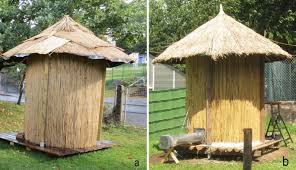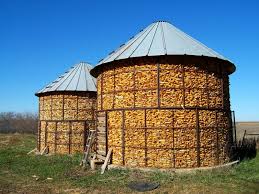Normal storage is defined as the keeping of foodstuffs open to the atmosphere, subject to room temperature and humidity.
In reality, storage of foodstuffs begins immediately after the crop is detached or harvested from the parent plant. Decomposition caused by fungi, bacteria, and nematodes starts in the field and continues during the course of storage.
Food Security Challenges: Increasing Production and Reducing Post-Harvest Losses
Food self-insufficiency in Nigeria depends on increased production, reduced post-harvest losses, improved processing methods, and improved product distribution.
However, an increase in food production, improved processing methods, and better product distribution cannot be effective unless post-harvest losses are studied and improved upon when necessary.
Read Also: 12 Medicinal Health Benefits of Oats (Avena Sativa)
Traditional Food Storage Methods Among Smallholder Farmers

More than three-quarters of the agricultural output of African smallholder farmers is kept at village level for local use and stored using traditional methods. Household-level storage offers several advantages:
1. Stores food close to the majority of consumers
2. Gives farmers easy access to their assets and facilitates sale transactions
3. Eliminates transport and handling costs and reduces losses occurring at these stages
4. Serves as a source of information regarding grain supply, informing production decisions
If household storage is still full during farming preparations, it may signal an oversupply of that grain type on the market, influencing the farmer to adjust crop acreage accordingly.
The type of foodstuff and crop quantity determine the design and capacity of storage facilities. Farmers store crops either outside (suspended or on platforms), in granaries, or inside their homes.
Areal Storage of Crops: Hanging and Drying in Open Air
Unshelled maize cobs and other unthreshed cereals are suspended in bunches or sheaves using rope or plant materials, hung under eaves, tree branches, or poles driven into the ground.
The grain dries naturally in air and sunlight until needed for consumption or sale. The disadvantage is exposure to environment and pests.
Ground Storage for Temporary Crop Holding
Storage on the ground is for temporary use immediately after harvesting, lasting only a few days. This method allows drying when there is no rain threat but is inefficient and unsuitable for tropical areas due to high dampness. If used, the grain should be placed on a tarpaulin to reduce moisture absorption.
Platform Storage: Elevated and Protected Crop Storage
Platforms consist of straight poles laid horizontally on upright posts, raised 35–40 cm indoors for cleaning or about 1 meter outdoors. They can be rectangular, circular, or polygonal. Grain is stored in heaps, baskets, or bags. In humid climates, fires may be lit under elevated platforms to dry produce and deter pests.
Conical-shaped platforms improve drying by funneling air. The conical platform frame rests on a central supporting post.
Cribs: Improved Traditional Storage with Ventilation
Cribs are ventilated structures made from bamboo, grass stalks, or wire netting, positioned to allow prevailing winds to blow across their length.
In humid areas, cribs made from plant materials like timber, reeds, and bamboo allow aeration during storage. Some NGOs introduced wood and chicken-wire cribs in Rwanda and Uganda, but farmers in Kenya rejected wire sides due to theft risk. Some traditional crib designs lack rat-proofing measures.
Dwellings as Storage: Using Heat and Smoke to Protect Grain
Unthreshed cereals are often stored under dwelling roofs, hanging from roof timbers or spread on grids above fires. The heat and smoke deter insects, and these reserves are for daily consumption, easily accessible and protected from theft and pests.
Mud Granaries: Clay-Based Storage Structures
Mud granaries are made of clay mixed with plant fragments or termite mound clay, sometimes constructed with clay bricks. They are insulated from the ground by wooden poles, pedestals, or stones.
Shapes may be circular or rectangular with compartments. In Senegal, mud granaries have central corridors with fires to dry stored paddy sheaves. Some granaries have straw roofs or are entirely mud-built.
These granaries are common in Nigeria, Chad, Mali, Mauritania, and Niger, suited for dry climates and can hermetically seal grain, limiting insect development due to low oxygen.
Ventilation absence requires grain moisture below 10% and humidity less than 70%. They are vulnerable to heavy rain and require crack sealing.
Traditional Maize Storage Techniques in Agriculture
Traditionally, maize farmers use various cribs to store maize cobs at the village level. These cribs offer limited facilities for continuous drying, insect control, and rodent prevention.Therefore, an improved maize crib design has been introduced to enhance maize storage efficiency at this level.
Read Also: 12 Medicinal Health Benefits of Emilia Sonchifolia (lilac tasselflower)
Construction of the Maize Crib: Site and Shape Considerations

1. Site Selection: The crib should be constructed on a level, clear site free from trees and bushes. Good ventilation and breeze improve drying. Raised ground is preferable.
2. Crib Shape: Rectangular shape is preferred. Length varies with quantity of maize, width ranges from 90 cm (wetter areas) to 150 cm (dry areas). A standard width of 120 cm is recommended. One ton of maize requires about 150 cm length, 120 cm width, and 120–150 cm height storage space.
Crib Orientation for Effective Ventilation
The long side of the crib should face the prevailing wind direction to allow airflow through maize cobs for efficient drying. The crib width should never exceed 150 cm to maintain free air passage.
Basic Parts and Construction of the Maize Crib
The crib consists of two parts:
1. Platform supporting the maize cob weight
2. Framework supporting the sides and roof
Construction Procedure:
- Mark location, size, and orientation.
- Set platform support poles 30–40 cm deep, spaced to support the platform about 120 cm above ground. Bamboo is recommended where available.
- Fix horizontal poles on top of platform supports lengthwise and widthwise to create a rigid platform.
- Insert two 400 cm poles at crib ends for ridge support; add extra ridge supports if needed.
- Erect vertical 300 cm poles near platform supports for side and roof framing.
- Lash or nail horizontal poles at crib ends and ridge supports to stabilize the structure.
- Attach light framework of palm-leaf midribs or split bamboo from ridge poles to upper horizontal poles, weaving to form roof base.
- Roof is made from grass (preferably ekong grass) or raffia leaves woven traditionally and fixed to the roof framework.
- Construct retaining walls of horizontal poles nailed or lashed to roof supports to desired maize height, leaving one gap for access.
Rodent and Pest Prevention Measures
- Cover crib walls and floor with 2 cm mesh chicken wire or palm midrib/bamboo lattice secured to support the weight of maize.
- Bamboo vertical poles help prevent rat climbing if the platform is at least 120 cm high.
- For other materials, rodent guards made from iron or aluminum sheets form cones around crib legs, fixed above ground with open cone end facing downward, leaving no gaps for rat entry.
- Keep surrounding area clear of plants and farm tools to prevent rodents climbing into the crib.
Do you have any questions, suggestions, or contributions? If so, please feel free to use the comment box below to share your thoughts. We also encourage you to kindly share this information with others who might benefit from it. Since we can’t reach everyone at once, we truly appreciate your help in spreading the word. Thank you so much for your support and for sharing!

